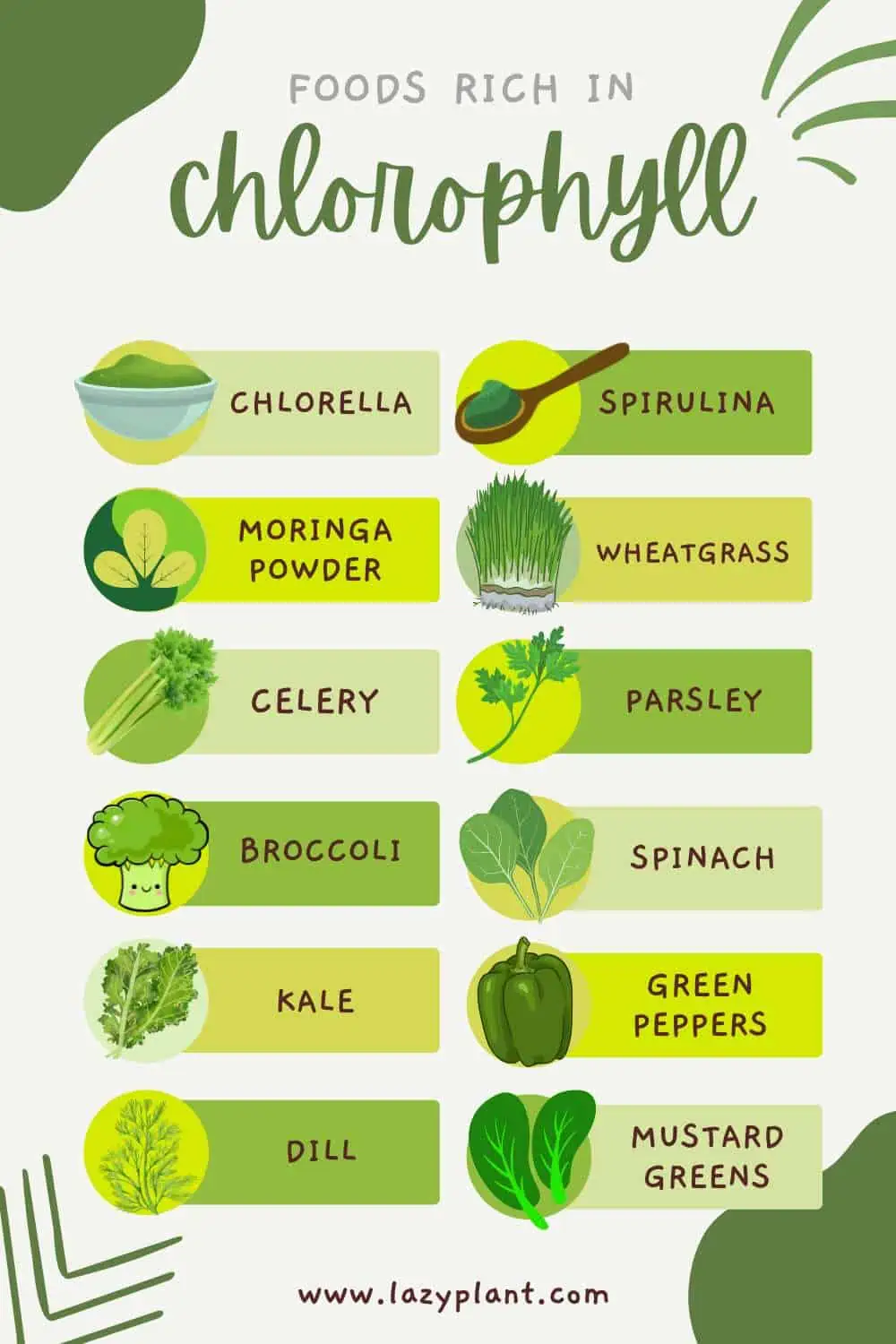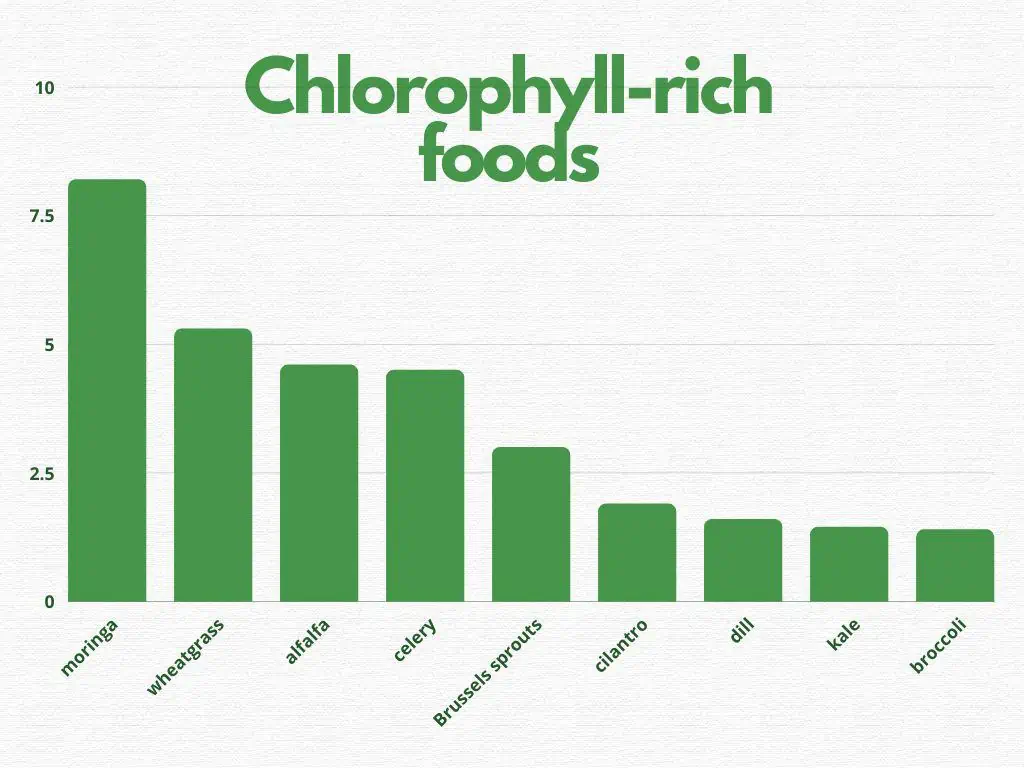Plants are the only dietary sources of chlorophyll. Chlorella, spirulina, wheatgrass, moringa powder, mustard greens, alfalfa, celery, parsley, dill, broccoli, spinach, and kale are only a few of the richest foods in chlorophyll.
Health Benefits of Chlorophyll
Above all, chlorophyll fights oxidative stress and has powerful anti-inflammatory properties. Actually, many health claims have been made about chlorophyll.
Chlorophyll supplies oxygen to tissues, helps the body detox, protects the liver, increases energy levels, boosts the immune system, supports weight loss, has anti-aging properties, helps with acne problems, and may help prevent certain types of cancer.[1,2,3]
What Foods Contain Chlorophyll?
Chlorophyll is naturally found in plants. Chlorophyll is important for photosynthesis. It helps plants absorb energy from sunlight and gives them their green color.
As a rule of thumb, green fruits and vegetables are rich in chlorophyll. Plants with dark green leaves, seaweed, and algae are the richest foods in chlorophyll.
| Foods with high Chlorophyll Content | alfalfa, asparagus, broccoli, Brussels sprouts, celery, chlorella, cilantro, collard greens, dill, kale, matcha green tea, mustard greens, nettles, parsley, spinach, spirulina, sprouts, turnip greens, wheatgrass, moringa powder |
| Foods with medium Chlorophyll Content | arugula, Chinese cabbage, cress, endive, green beans, green cabbage, green peas, green pepper, leeks, lettuce |

Moringa powder and wheatgrass powder are the richest foods in chlorophyll. Other common foods particularly rich in chlorophyll are alfalfa, celery, and Brussels sprouts.
| Chlorophyll (mg/g) | |
| moringa powder | 8.2 |
| wheatgrass | 5.3 |
| alfalfa | 0.39–4.60 |
| celery | 2.5 – 4.5 |
| Brussels sprouts | 3 |
| cilantro | 1.9 |
| matcha green tea | 1.12-1.89 |
| dill | 1.63 |
| kale | 1.45 |
| broccoli | 1.4 |
| parsley | 1.36 |
| nettles | 1.2 |
| spinach | 0.85 |
| green pepper | 0.5-0.8 |
| cress | 0.56 |
| green beans | 0.3 |
| arugula | 0.29 |
| leeks | 0.27 |
| green peas | 0.2 |
| lettuce | 0.18 |
| endive | 0.18 |
| Chinese cabbage | 0.14 |
| green cabbage | 0.075 |
| olive oil | 0.008 – 0.068 |
As a rule of thumb, follow a whole food plant-based diet rich in green vegetables, herbs, and spices to skyrocket your daily chlorophyll intake!
Moringa Powder is the richest food in Chlorophyll
The best dietary source of chlorophyll is moringa powder. Fresh moringa leaves contain approximately 2.1 mg of chlorophyll per gram, whereas moringa powder contains up to 8.2 mg of chlorophyll per gram.
Moringa powder has amazing nutritional value. It’s particularly high in beta-carotene, lutein, zeaxanthin, vitamin C, and vitamin E. Thus, moringa powder protects our vision.
You can find moringa powder on iHerb. Sign up for our newsletter (▼below) for a 5% off coupon on all your orders!
The second-richest food in chlorophyll is wheatgrass. Wheatgrass contains about 5.3 mg of chlorophyll per gram. It’s estimated that 100 grams of wheatgrass powder are equal to 23 kg of vegetables!
Wheatgrass has many health benefits due to its high chlorophyll content. Wheatgrass has anti-inflammatory, antioxidant, anti-carcinogenic, immune boosting, laxative, antibacterial and anti-aging properties.[5]
Keep in mind that people taking blood-thinning drugs should consult their physician, before consuming wheatgrass. Wheatgrass is particularly high in vitamin K, which is a blood-clotting agent. Other than that, wheatgrass consumption is considered pretty safe.

Other foods high in Chlorophyll
Most noteworthy, spinach is one of the most common foods high in chlorophyll. It contains about 0.85 mg of chlorophyll per gram. Frozen spinach has a similar chlorophyll content to fresh spinach. Therefore, you can add frozen spinach to your favorite smoothie to really increase your chlorophyll intake.[6]
Celery is another excellent dietary source of chlorophyll. Celery contains about 2.5-4.5 mg of chlorophyll per gram. In fact, celery juice is a natural source of concentrated liquid chlorophyll.
Brussels sprouts contain high amounts of chlorophyll as well. They contain approximately 3 mg of chlorophyll per gram.
Other common foods high in chlorophyll are:
- kale (1.45 mg),
- broccoli (1.4 mg),
- green pepper (0.5 mg),
- arugula (0.29 mg),
- lettuce (0.18 mg),
- green cabbage (0.075 mg).
Prefer to consume these chlorophyll-rich foods raw in salads. Chlorophyll is vulnerable to heat. Cooked vegetables have a lower chlorophyll content than fresh vegetables.

Chlorella, Spirulina & other Seaweed contain Chlorophyll
Other foods high in chlorophyll are seaweed and algae.
- Chlorella is the richest algae in chlorophyll. It’s up to 4% chlorophyll.
- Spirulina is up to 1% chlorophyll.
- Sea lettuce, dulse, laver, nori, and kelp contain decent amounts of chlorophyll as well.
Moreover, chlorella is one of the few plant-based sources of vitamin B12.
Only spirulina and chlorella consumption is safe, though. Most other seaweeds contain too much iodine, which can be dangerous in high amounts.
How to store foods with Chlorophyll?
Store veggies at low temperatures to keep vegetables and fruits fresh for longer.
Furthermore, according to studies, vegetables that are maintained in lower temperatures have a higher chlorophyll content. Keeping your veggies at 5oC may contain up to 60% more chlorophyll than keeping them at 20oC.
Moreover, fresh fruits and vegetables contain more chlorophyll than dried ones. For instance, dried broccoli has only 0.15 mg of chlorophyll per gram, while fresh broccoli has more than 1.44 mg of chlorophyll per gram.[7]
Finally, you can grow microgreens or sprouts. Microgreens and sprouts from buckwheat, broccoli, alfalfa, or mustard seeds are particularly rich in chlorophyll.
Is Chlorophyll from Supplements good for you?
Certainly, you can get high amounts of chlorophyll from food. But, you can also boost your chlorophyll intake from dietary supplements.
Liquid chlorophyll supplements don’t contain chlorophyll, but a compound called chlorophyllin, which is identical to chlorophyll.
You can find a wide variety of chlorophyll supplements (liquid or capsules) on iHerb.